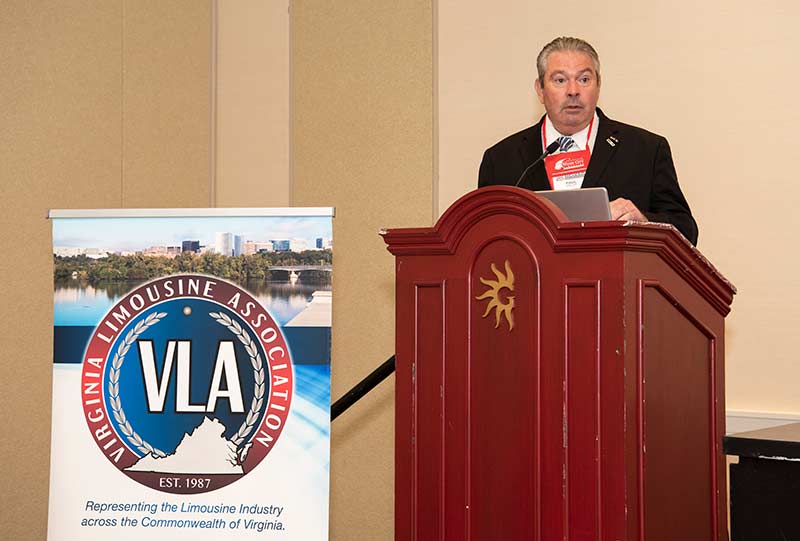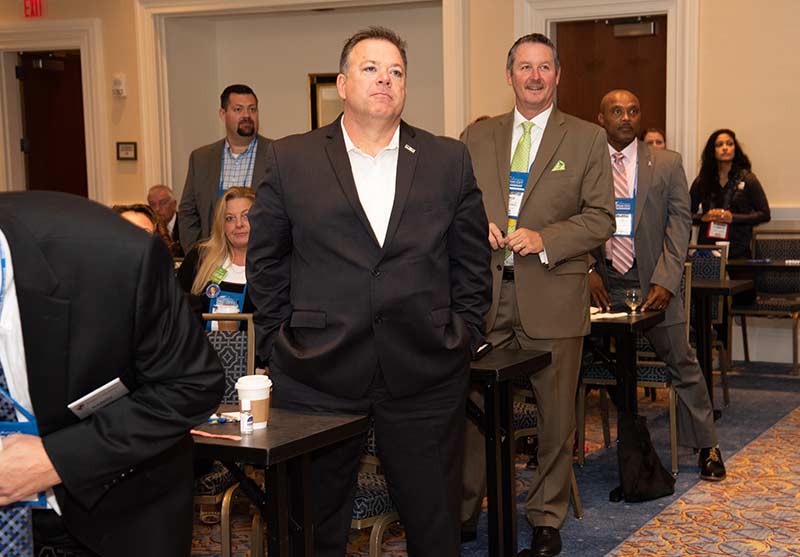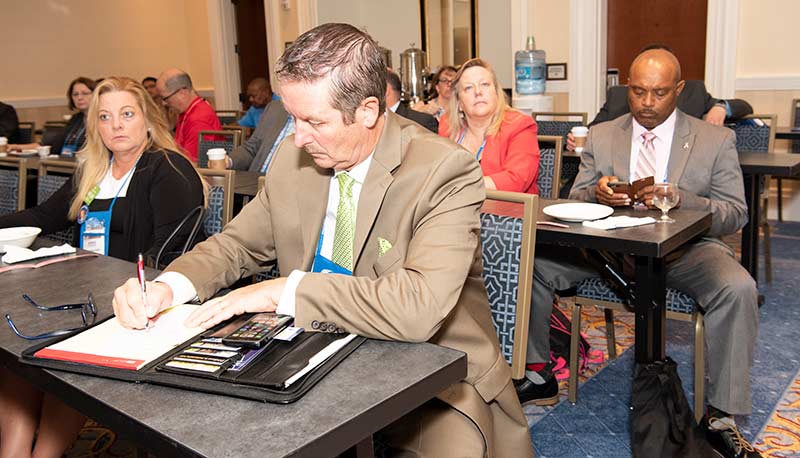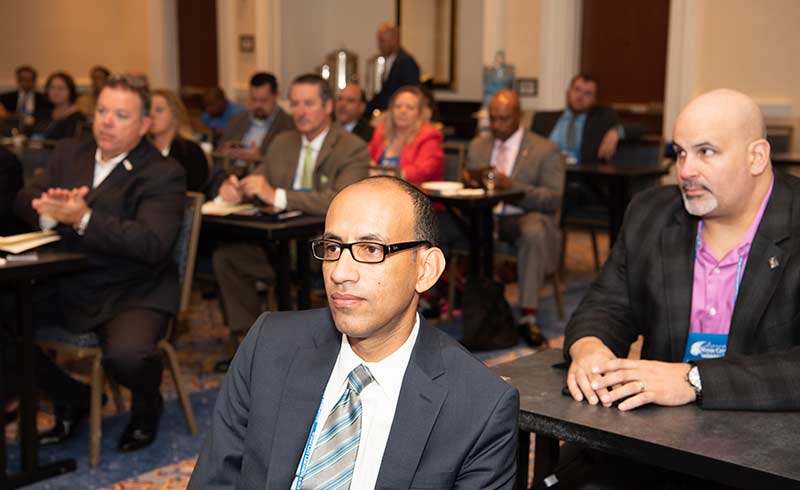 VLA President Paul Walsh of Superior Executive Transportation
National Harbor, Md. —More than 50 attendees joined the Virginia Limousine Association (VLA) for a membership meeting hosted at the 2018 CD Show at the Gaylord National. The October 8 gathering attracted not only VLA members but also supporters from all across the industry.
VLA President Paul Walsh of Superior Executive Transportation
National Harbor, Md. —More than 50 attendees joined the Virginia Limousine Association (VLA) for a membership meeting hosted at the 2018 CD Show at the Gaylord National. The October 8 gathering attracted not only VLA members but also supporters from all across the industry.
President Paul Walsh of Superior Executive Transportation kicked off the meeting, recognized the officers comprising the VLA board, and thanked the numerous meeting sponsors before inviting Brent Maitland of MCI to the podium, who spoke of how getting to know the livery side of ground transportation is helping the bus manufacturer meet luxury operators’ specific needs.
“Part of our growth has been from operators getting into motorcoaches, so it’s important for us to know what’s going on with you and how motorcoaches are different from what you usually operate,” Maitland said. “What you tell us helps us develop the training and tools that will help operators and chauffeurs.”
VLA Treasurer Randy Allen of James Limousine Service organized a panel discussion for the meeting: He introduced the four panelists who would be tackling the most pressing farm-in/farm-out questions, as well as discussing the software and procedures that would help streamline affiliate work. VLA Sergeant of Arms Zulfi Abassi of American Executive Transportation, Joe Cardillo of AOT Global, Mark Kini of Boston Chauffeur, and Tracy Raimer of Windy City Limousine represented a wide array of regional markets, company sizes, and software users.
 VLA Vice President William Kerr of Camryn Executive Transportation
“We wanted to educate our meeting attendees about current strategies regarding the farm-in/farm out process, how we can optimize pre-planned trips, meeting the needs of our clients, and ways to communicate those needs to our software providers,” he explained before the panelists began taking questions. “As Uber keeps offering new things to their riders, we’re falling further behind in customer expectations: TNCs allow passengers to upload their receipts directly and immediately to expense programs, while we’re still struggling to deliver some of the basics.”
VLA Vice President William Kerr of Camryn Executive Transportation
“We wanted to educate our meeting attendees about current strategies regarding the farm-in/farm out process, how we can optimize pre-planned trips, meeting the needs of our clients, and ways to communicate those needs to our software providers,” he explained before the panelists began taking questions. “As Uber keeps offering new things to their riders, we’re falling further behind in customer expectations: TNCs allow passengers to upload their receipts directly and immediately to expense programs, while we’re still struggling to deliver some of the basics.”
Allen asked the panelists several questions, exploring topics like “Are you losing clients and potential revenue due to your current farm-in/farm-out process?” and “What recent advancements in your farm-in/farm-out processes have raised your level of service?” The questions, along with audience insights, painted a picture of an industry that understands the need to constantly improve communications—among operators and industry technologies alike.
A recurring pain point among those in attendance was the inability for certain software systems to “speak” to one another, a frustration that many felt forced them to choose among affiliates based on comparable technology rather than their quality of service—or, as Kini put it: “Similar principles should dictate affiliate partnerships, not just similar technology.”
 More than 50 attendees were present for the October 8 meeting
“Imagine if you couldn’t communicate with people using a different cellular carrier than you are,” Allen added. “We need to adapt.”
More than 50 attendees were present for the October 8 meeting
“Imagine if you couldn’t communicate with people using a different cellular carrier than you are,” Allen added. “We need to adapt.”
The prevailing opinions were that the industry needs to work together to find the best solutions for its problems, whether it’s acting as a united voice imploring the industry’s technology providers to offer the options that TNC-savvy passengers are demanding, making technology more accessible to the operators who can’t quite wrap their heads around its intricacies, and that it’s time to leave egos at the door and work together to find the best solutions for the industry as a whole so it can not only move forward but also keep up with the times.
“It’s not our place to tell another company what to do and how to do it,” Cardillo said of diplomatically making operators’ needs—and their clients’ demands—known to the industry’s software companies. “We can make suggestions but each company is the master of its goals and development. But the pathway to what we want is there.”
 Industry members from across the country attended the VLA meeting
One suggestion from the audience highlighted the importance of uniting behind a common goal: “One technology company’s 5,000 clients all asking for different ways to do one thing isn’t helping anyone. If we come together with one voice and give them one item to concentrate on—and maybe even make a one-time donation to support that infrastructure development—that can help make the connectivity we want happen.”
Industry members from across the country attended the VLA meeting
One suggestion from the audience highlighted the importance of uniting behind a common goal: “One technology company’s 5,000 clients all asking for different ways to do one thing isn’t helping anyone. If we come together with one voice and give them one item to concentrate on—and maybe even make a one-time donation to support that infrastructure development—that can help make the connectivity we want happen.”
The next VLA meeting will be its holiday gala, which will be held December 3 in Fredericksburg, Va.
Visit
vla-limo.org for more information.
[CD1018]
VLA Meeting Hosts Diverse Operator Panel
- Details
- Category: Industry News

